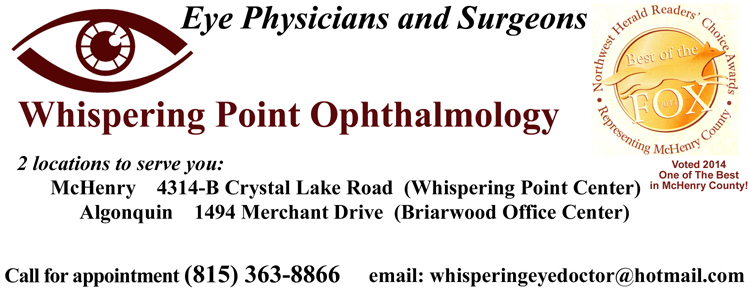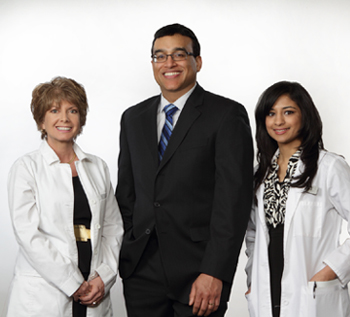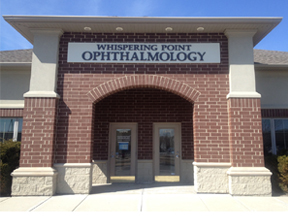

The team of ophthalmic physicians and surgeons, opticians and optometrists at Whispering Point Ophthalmology provide a wide range of vision care.
General Ophthalmology
Comprehensive Eye Exams: A thorough exam is performed to evaluate the overall health of the eye, and if necessary a prescription is made for eyeglasses.
Contact Lenses Exams: A contact lens evaluation is performed to ensure that patients who wear contact lenses experience good vision, comfort, and safety from their lenses.
Emergency Eye Care: Work-related injuries, foreign body removal, etc.
- -Dry eye and blepharitis
- -Allergic/Bacterial/Viral conjunctivitis
- -Contact-lens related problems
- -Eye infections (ie. corneal ulcers, herpes simplex and herpes zoster (shingles), uveitis, etc)
- -Cataracts (consultation and surgery is offered)
- -Glaucoma (medical and surgical therapy is offered)
- -Diabetes
- -Macular Degeneration
- -Refractive errors (nearsighted, farsighted, presbyopia, and astigmatism)
- -Eye Trauma
Our Optical Department provides eyeglass fitting, adjustment and repair. We offer a large selection of eyeglass frame designs for all corrective needs and for all faces.
We offer additional testing with advanced technology to manage certain eye conditions such as:
- -Humphrey Visual Field We offer the Humphrey Visual Field screening which can detect central and peripheral vision problems. This is useful in conditions affecting the eye, optic nerve, and brain.
- -Ocular Coherence Tomography (OCT) We also offer the Ocular Coherence Tomography (OCT), which is a scan that captures detailed images of the retina in the back of the eye. This test is useful in assessing subtle changes of the optic nerve and macula. The OCT is a useful tool to monitor the progression of conditions such as macular degeneration, glaucoma, etc.
- -Tonometry This is the measurement of eye pressure which is the pressure of fluid within the eyeball. We use an instrument called the probe to take the eye pressure readings.
- -Pachymetry This is the measurement of corneal thickness which is useful when evaluating eye pressure readings since a thin or thick cornea can affect eye pressure results.
McHenry - Whispering Oaks Office Center
4314-B Crystal Lake Road
Hours: Monday Tuesday Wednesday Friday
Algonquin - Algonquin Commons
1494 Merchant Dr.
Hours: Monday Tuesday Wednesday Thursday Friday Saturday


Dr. Maureen Richards, M.D.
Dr. Maureen Richards is a board certified ophthalmologist and fellow of the American Board of Ophthalmology specializes in providing a full spectrum of eye care, from prescribing glasses and contact lenses to complex and delicate eye surgery. She received her medical degree from Rush University Medical College and completed her ophthalmology training at the Eye Institute of the Medical College of Wisconsin. She is very thorough, caring, and knowledgeable. Dr. Richards is a Chicago native and is a proud wife and mother of two children.

Dr. Joseph Kappil, M.D.
Dr. Joseph Kappil is a board certified comprehensive ophthalmologist who is a native of the Chicago land area. He finished his undergraduate education at the University of Chicago. Graduating from Loyola Stritch School of Medicine in 1994, he then pursued his dream of treating eye disease by completing his ophthalmology training at Loyola University Medical Center in 1998. Dr. Kappil specializes in cataract surgery and offers multifocal and toric intraocular lens implantation. He treats glaucoma patients with the latest medical, surgical, and laser equipment. He also performs laser surgery to treat diabetics and patients with floaters who develop retinal tears. Dr. Kappil enjoys treating patients of all ages for all vision care, from advanced procedures to "regular" eye check ups. Dr. Kappil is married and has three children.

Dr. Seher Shiekh, O.D.
Dr. Shiekh joined our practice recently and is the newest member of our team. She completed her undergraduate studies at the University of Illinois at Chicago. She then graduated from Illinois College of Optometry where she received her Doctor of Optometry and Bachelors of Visual Science degree. She takes pleasure in providing eye exams to patients of all ages and enjoys educating patients in regards to their eye health and vision. Dr. Shiekh has a particular interest in primary care, contact lens fittings, and ocular disease. She strongly believes the most important aspect of patient care is good communication and education which is essential in maintaining optimum eye health. Dr. Shiekh enjoys spending time with her family and friends, traveling, as well as performing outdoor activities. She is looking forward to helping the Algonquin office grow!
Cataract
A cataract is the clouding of the normally clear lens of the eye. The clouding prevents light entering the eye from being focused on the lining of the back of the eye, called the retina. The lens clouds naturally as we age, resulting in a gradual decrease of eyesight. They may also occur secondary to medication, hereditary factors, trauma, inflammation, metabolic or nutritional disorders, or radiation. Cataracts usually progress slowly to cause visual loss and are potentially blinding if left untreated.
Dry Eye
Dry eye is a condition in which there are insufficient or poor quality tears to lubricate and nourish the eye. This can lead to itching, redness and pain from dry spots on the surface of the eye. Tears are necessary for maintaining the health of the front surface of the eye and for providing clear vision. Tears are composed of three layers: the outer oily layer, the middle watery layer, and the inner mucous layer. Dry eye is a common and often chronic problem, particularly in older adults.
Flashes and Floaters
Floaters are common eye symptoms that occur as a result of age-related changes to the vitreous gel. Floaters can be specks, strands or webs and most visible when looking at a uniform light background like the sky or lightly-colored wall. As we age, the vitreous begins to liquefy and debris that was once secure in the gel can now float around, casting shadows on the retina. Eventually the vitreous gel begins to shrink and separate from the retina. As the vitreous continues to peel free, it might reach a point where it is firmly attached to the retina and the traction can cause rapid-fire flashes like a strobe. Sometimes, the vitreous tugs so forcefully that it causes a hole or tear in the retina. If you experience an increase or onset of floaters or if you see flashing lights, it is important to be examined promptly. Most eyes with these symptoms do not have a retinal tear, but those that require treatment to seal a tear will prevent a more serious problem such as a detached retina.
Glaucoma
Glaucoma is the leading cause of blindness and visual impairment in the US, and can affect patients of all ages. Glaucoma refers to a condition that causes damage to the optic nerve, the connection from your eye to your brain, as a result of increased pressure within the eye, but can also be caused by a severe eye infection, injury, blocked blood vessels or inflammatory conditions of the eye. Many patients do not experience any symptoms during the early stages of glaucoma, and have no pain and no vision loss. This makes it difficult for many patients to know if they have the disease. But as glaucoma progresses, patients may experience a loss of peripheral or side vision, along with sudden eye pain, headache, or blurred vision.
Diabetic Retinopathy
Diabetes is a disease that interferes with the body's ability to use and store sugar, which can cause many health problems. Too much sugar in the blood can cause damage throughout the body, including the eyes. Over time, diabetes affects the circulatory system of the retina. Diabetic retinopathy is a leading cause of blindness in adults. Diabetic retinopathy develops as a result of changes in blood sugar levels or simply the presence of long-term diabetes. If high blood sugar levels cause blood vessels in the retina, the light sensitive lining at the back of the eye,to leak blood or fluid, the retina may become swollen and form deposits. Patients who develop diabetic retinopathy may not notice any changes to their vision at first. In its earliest stages, this condition causes tiny areas of swelling in the small blood vessels of the retina. More and more blood vessels can become blocked, and the retina may send signals for new blood vessels to be grown. Early stages of diabetic retinopathy do not usually require treatment, but patients should monitor their blood sugar level to prevent the disease from progressing. If the disease does progress, treatment may be necessary to preserve your vision.
Age-Related Macular Degeneration (AMD)
Macular Degeneration is the leading cause of severe vision loss in adults over age 65. This eye disease occurs when there are changes to the macula, a small portion of the retina that is located on the inside back layer of the eye that is responsible for the crisp, detailed vision needed for reading or driving. As we age, the tissue in the eye responsible for central vision slowly begins to deteriorate which can significantly affect a patient's quality of life. AMD is a loss of central vision that can occur in two forms: "dry" or "wet". Most people with macular degeneration have the dry form, for which there is no known treatment. The less common wet form may respond to laser procedures, if diagnosed and treated early. Some common symptoms are: a gradual loss of ability to see objects clearly, distorted vision, a gradual loss of color vision, and a dark or empty area appearing in the center of vision. If you experience any of these, contact your eye doctor immediately for a comprehensive examination. Central vision that is lost to macular degeneration cannot be restored. However, low vision devices, such as telescopic and microscopic lenses, can be prescribed to maximize existing vision. Researchers have linked eye-friendly nutrients such as lutein/zeaxanthin, vitamin C, vitamin E, and zinc to reducing the risk of certain eye diseases, including macular degeneration.